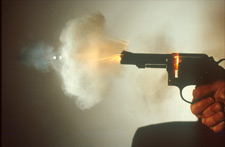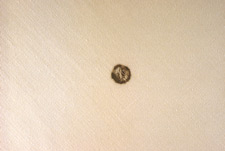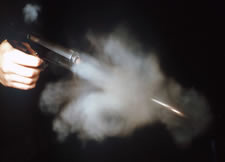Home | Glossary | Resources | Help | Contact Us | Course Map
Archival Notice
This is an archive page that is no longer being updated. It may contain outdated information and links may no longer function as originally intended.
Vaporous Lead Residues
Vaporous lead (smoke) residues are characteristically deposited at closer ranges. These deposits are chemically detectable by an application of the Sodium Rhodizonate Test.
Results are useful in
- determining the maximum distance of the vaporous lead deposits,
- corroborating the results of the Modified Griess Test.
This type of residue is projected from the muzzle of a firearm as a cloud-like array. However, these smoke residues are projected only to a particular maximum distance. This distance can be determined by experimentation using the suspect firearm and ammunition in known-distance test firings.
Residues Consistent with the Passage of a Bullet
Holes found in objects, such as garments, with no accompanying particulate residues may appear consistent with the passage of a bullet. Positive results for the presence of any copper-bearing or lead-bearing residues (bullet wipe) from either or both of the Dithiooxamide Test and the Sodium Rhodizonate Test are consistent with the passage of a bullet.
Residues Consistent with the Discharge of a Firearm
In many instances, the discharge of a firearm will result in the deposit of particulate lead around a bullet hole. This deposit may be in the form of tiny solidified droplets resulting from the surface erosion of a bullet during its passage through the barrel, ejecta from a dirty barrel, or lead shavings from the surface of a bullet.
Such residues may be visible and are chemically detectable. However, these residues are not reproducible and therefore are not useful for a distance determination. On the other hand, they are consistent with the discharge of a firearm.
Additional Online Courses
- What Every First Responding Officer Should Know About DNA Evidence
- Collecting DNA Evidence at Property Crime Scenes
- DNA – A Prosecutor’s Practice Notebook
- Crime Scene and DNA Basics
- Laboratory Safety Programs
- DNA Amplification
- Population Genetics and Statistics
- Non-STR DNA Markers: SNPs, Y-STRs, LCN and mtDNA
- Firearms Examiner Training
- Forensic DNA Education for Law Enforcement Decisionmakers
- What Every Investigator and Evidence Technician Should Know About DNA Evidence
- Principles of Forensic DNA for Officers of the Court
- Law 101: Legal Guide for the Forensic Expert
- Laboratory Orientation and Testing of Body Fluids and Tissues
- DNA Extraction and Quantitation
- STR Data Analysis and Interpretation
- Communication Skills, Report Writing, and Courtroom Testimony
- Español for Law Enforcement
- Amplified DNA Product Separation for Forensic Analysts




